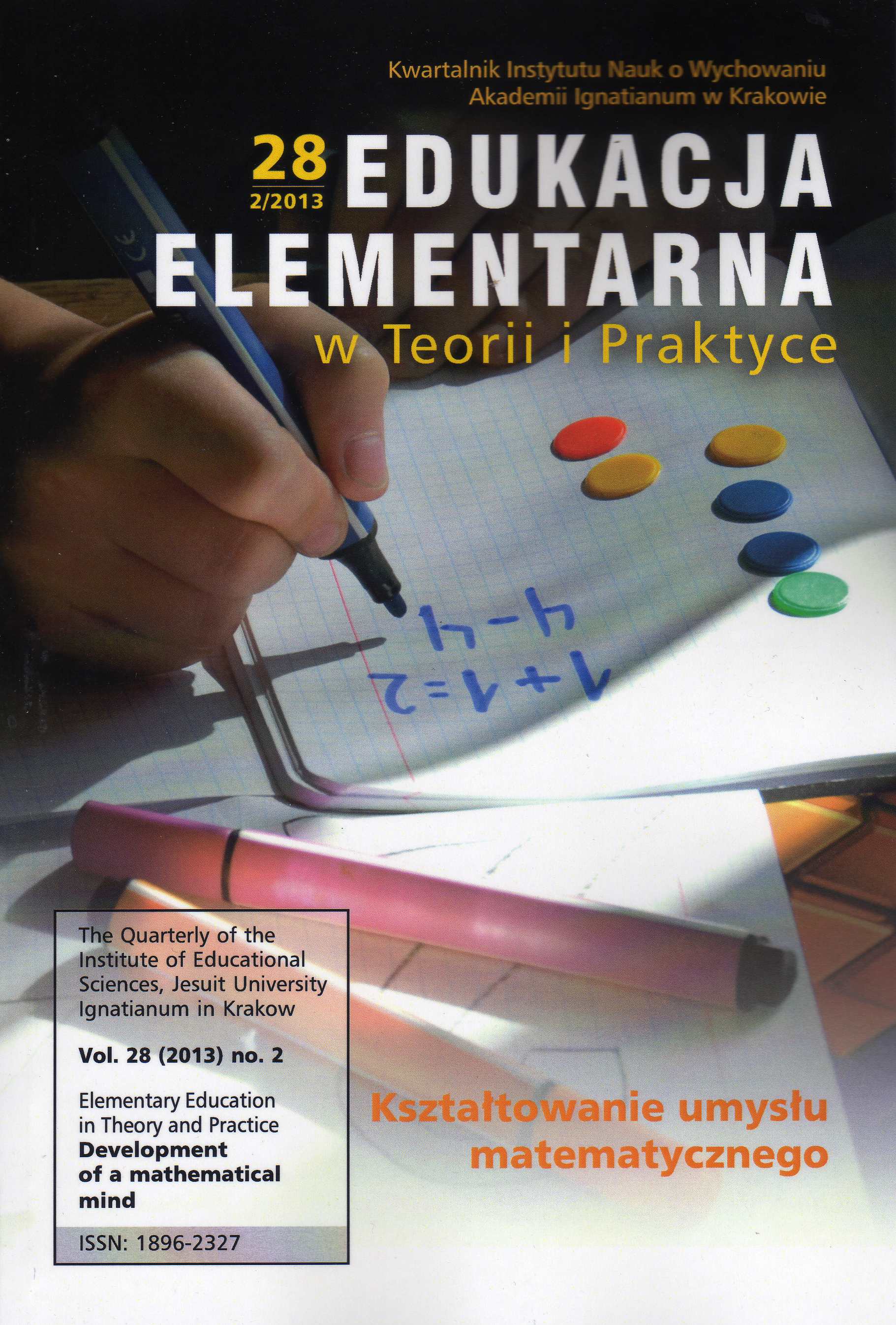Czy zbiory rozmyte wykorzystujemy w edukacji wczesnoszkolnej?
Abstrakt
Zbiory rozmyte (ang. fuzzy sets) kojarzą się najczęściej z bardzo skomplikowanymi, współczesnymi obliczeniami w matematyce, stanowiąc podstawę funkcjonowania najnowocześniejszych urządzeń, jak sondy kosmiczne czy bezzałogowe samoloty i łodzie podwodne. Czyż można się więc spodziewać elementów tychże zbiorów w edukacji przedszkolnej i wczesnoszkolnej? Jednakże dokładne przejrzenie obu tych cyklów edukacyjnych upoważnia do stwierdzenia, iż elementy zbiorów rozmytych służą interpretacji nie tylko różnych działów matematyki, lecz także fizyki, biologii czy językoznawstwa, a w nauczaniu zintegrowanym wspomagają edukację przyrodniczo-społeczną związaną z kręgami bliskości (dom, najbliższa okolica, moja miejscowość, strony rodzinne), edukacją polonistyczną z wychowaniem do sztuki i kultury oraz edukacją matematyczną. W nauczaniu zintegrowanym nauczyciel i uczniowie używają zarówno wielkości mierzalnych nieokreślonych, znanych z potocznej polszczyzny, typu wysoki / niski, duży / mały, gruby / chudy, szybki / wolny, ciężki / lekki, ładny / brzydki, jak i działań matematycznych ze znakami >; < ‘większy niż’, ‘mniejszy niż’ np. x>y, y<x oznaczających porównanie wielkości, gdzie nieostrość wiąże się z odczytaniem relacyjnym ipso facto symboli niedookreślonych, podczas gdy rachunki wnoszą wartość równości /równoliczebności. Inny jest więc status obu działań: raz mieszczących się w teorii mnogości (i logice dwuwartościowej), klasycznej definicji prawdy jako zgodności słów z rzeczywistością i obiektywnej teorii interpretacji rzeczywistości, a drugim razem – w logice wielowartościowej uwzględniającej wartość trzecią – możliwość, poza klasyczną definicją prawdy, a sama wartość możliwości leży poza kategoriami: prawdy (1) i fałszu (0). Porównanie wielkości wiąże się z nieostrością, stosowaną do odczytania znaków x>y, y<x. Wielkości mierzalne nieokreślone typu duży / mały, szybko / wolno, pojawiają się często w zadaniach matematycznych, aby wprowadzić dzieci w temat, a potem następuje wyjaśnienie typu pociąg jechał z prędkością 140 km/godz. / wartość mierzalna określona). Znaki relacyjne >; < ‘większy niż’, ‘mniejszy niż’ sprzyjają myśleniu abstrakcyjnemu u dzieci, wpływając twórczo na rozwój kategorii porównania, abstrahowania i uogólniania.Bibliografia
Baścik-Kołek D. i in. (red.), Nasza klasa. Część 1, 2, 3, 4, 5. Przewodnik metodyczny klasa 1, Wyd. Grupa Edukacyjna SA, MAC, Kielce 2009.
Czogała E., Zbiory rozmyte. Wprowadzenie do matematycznego modelowania niejednoznaczności, Wyd. Naukowe PG, Gliwice 1997.
Dunaj B. (red.), Słownik współczesnego języka polskiego, Wyd. Wilga, Warszawa 1996.
Gruszczyk-Kolczyńska E., Zielińska E., Dziecięca matematyka. Metodyka i scenariusze zajęć z sześciolatkami w przedszkolu, w szkole i w placówkach integracyjnych, WSiP, Warszawa 2000.
Gruszczyk-Kolczyńska E., Zielińska E., Scenariusz: Potrafię sortować kolorowe kartoniki i ustalać, ile ich jest, i których jest więcej; Scenariusz: Czego jest więcej, czego mniej, a czego jest tyle samo?, [w:] Gruszczyk-Kolczyńska E., Zielińska E., Wspomaganie rozwoju umysłowego czterolatków i pięciolatków. Książka dla rodziców, terapeutów i nauczycieli przedszkola, WSiP, Warszawa 2005.
Gruszczyk-Kolczyńska E., Zielińska E., Wspomaganie dzieci w rozwoju do skupiania uwagi i zapamiętywania. Uwarunkowania psychologiczne i pedagogiczne, programy i metodyka, WSiP, Warszawa 2005.
Klus-Stańska D., Dyskursy pedagogiki wczesnoszkolnej, [w:] Pedagogika wczesnoszkolna – dyskursy, problemy, rozwiązania, red. D. Klus-Stańska, M. Szczepska-Pustkowska, Wyd. Akademickie i Profesjonalne, Warszawa, 2009, s. 26-79.
Kuhn T., The Structure of Scientific Revolutions, Wyd. Uniwersytetu w Chicago, Chicago 1962.
Nowakowska-Kempna I., Zbiory rozmyte i inne założenia matematyki i logiki w metodologii badań humanistycznych, [w:] Świat Techniki i Humanistyki, red. E. Tokarz, Wyd. Naukowe ATH, Bielsko-Biała 2007, s. 183-190.
Podstawa programowa z komentarzem. Tom 1. Edukacja przedszkolna i wczesnoszkolna z 23 grudnia 2008, opublikowana w dniu 15.01.2009, Dz. U. nr 4, poz. 17.
Tarski A., Pojęcie prawdy w językach nauk dedukcyjnych, „Prace Towarzystwa Naukowego Warszawskiego”, Wydz. III Nauk Matematyczno-Fizycznych, nr 34, Warszawa 1933.
Zadeh L., Fuzzy Sets, „Information and Control”, (1965)8, s. 338-353.
Zadeh L., Fuzzy Sets – Theoretic Interpretation on Linguistic Hedges, „Journal of Cybernetics”, (1972)2, s. 4-34.
Zadeh L., A Fazzy Algoritmic-Approach to the Definition of Complex or Imprecise Concepts, „International Journal of Man-Machine Studies”, (1978)8, s. 249-291.
Zadeh L., Toward a Theory of Fuzzy Information, Granulation and its Centrality in Human Reasoning and Fuzzy Logic, „Fuzzy Sets and Systems”, (1997)90, s. 111-127.
Copyright (c) 2016 Edukacja Elementarna w Teorii i Praktyce

Utwór dostępny jest na licencji Creative Commons Uznanie autorstwa – Bez utworów zależnych 4.0 Międzynarodowe.
1. Autor zgłaszając swój artykuł oświadcza, że jest Autorem artykułu (zwanego dalej Utworem) i:
- przysługują mu wyłączne i nieograniczone prawa autorskie do Utworu,
- jest uprawniony/a do rozporządzania prawami autorskimi do Utworu.
Oświadcza, że nie narusza praw autorskich osób trzecich i praw prawnych.
Oświadcza, że nie występuje żaden konflikt interesów.
2. Udziela Uniwersytetowi Ignatianum w Krakowie nieodpłatnej, niewyłącznej, nieograniczonej terytorialnie licencji do korzystania z Utworu na następujących polach eksploatacji:
- utrwalania utworu w formie papierowej, a także na nośniku cyfrowym lub magnetycznym;
- zwielokrotnienia utworu dowolną techniką, bez ograniczenia ilości wydań i liczby egzemplarzy;
- rozpowszechniania utworu i jego zwielokrotnionych egzemplarzy na jakimkolwiek nośniku, w tym wprowadzenia do obrotu, sprzedaży, użyczenia, najmu;
- wprowadzenia utworu do pamięci komputera;
- rozpowszechniania utworu w sieciach informatycznych, w tym w sieci Internet;
- publicznego wykonania, wystawienia, wyświetlenia, odtworzenia oraz nadawania i reemitowania, a także publicznego udostępniania utworu w taki sposób, aby każdy mógł mieć do niego dostęp w miejscu i czasie przez siebie wybranym;
- w zakresie praw zależnych do Utworu, obejmujących w szczególności prawo do dokonania koniecznych zmian w Utworze, wynikających z opracowania redakcyjnego i metodycznego, a także do dokonania tłumaczenia Utworu na języki obce.
Udzielenie licencji następuje z chwilą przekazania Utworu na rzecz Uniwersytetowi Ignatianum w Krakowie. Uniwersytet Ignatianum w Krakowie jest uprawniony do udzielania dalszych sublicencji do Utworu, w zakresie udzielonego prawa. Licencja jest ograniczona czasowo i zostaje udzielona na okres 15 lat, licząc od daty jej udzielenia.
Wyraża się zgodę i zachęca autorów do publikacji ich tekstu w Internecie (np. w repozytorium instytucji lub na jej stronie internetowej) przed lub podczas procesu składania tekstu jako, że może to prowadzić do korzystnych wymian oraz wcześniejszego i większego cytowania opublikowanego tekstu (Patrz The Effect of Open Access). Zalecamy wykorzystanie dowolnego portalu stowarzyszeń badawczych z niżej wymienionych:




